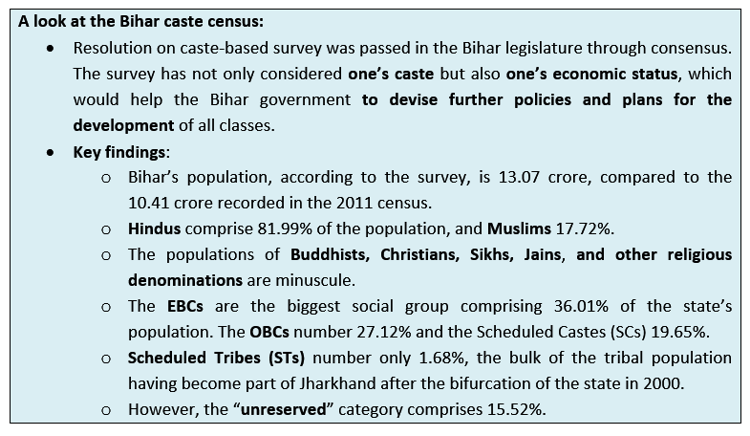IF CASTE IS AT CENTRE
| “The freedom to express varying and often opposing ideas is essential to variety of conceptions of democracy.” - Jonathan D. Casper |
Relevance: GS I, II (Social Issues and Governance)
- Prelims: Committees and Landmark Judgments for Caste issues in India
- Mains: Caste-based census and its associated issues in the reservation.
Why in News?
The politics of Caste diverts attention from the more difficult task of building institutions.
- The Bihar government released the results of its recently concluded survey of castes in the state, which resulted in demand for caste census in other states too.
What is Caste caste-based census?
- Socio-Economic and Caste Census (SECC) or the Caste-based census is a comprehensive study which examines the socio-economic status of rural as well as urban households. It also gathers information about the caste distribution within the population.
- Why there is a demand for a Caste-based Census?
- India runs the world’s largest affirmative welfare programme based on caste identity. Reservation for education and employment in government jobs are provided on the basis of caste identities.
- In such a scenario, the absence of fresh caste census data results in unequal justice. For example, the caste estimates of 1931 are being projected for formulating present welfare policies in 2021.
- The highest reservation mandate for the Other Backward Classes (OBCs) at 27% is caste according to the Mandal Commission on the basis of caste.

Background History of Caste-based Census:
- Every Census in independent India from 1951 to 2011 has published data on Scheduled Castes and Scheduled Tribes, but not on other castes. Before that, every Census until 1931 had data on caste.
- The Kaka Kelkar Commission in 1953 identified 2,399 backward castes, including 837 most backward castes. The Committee also recommended caste-based census in 1961. However, the recommendation was rejected.
- Caste–based census year-wise is shown in the table:
 Significance of caste-based census:
Significance of caste-based census:
- To address inequalities: As per Oxford Poverty and Human Development Initiative (OPHI) estimate, while STs, SCs and OBCs taken together comprised around 77.6% of the country’s poor in 2005-06, this share increased to almost 84% in 2015-16.
- The Sachar Committee report (2006) had estimated that 31% of Muslims were ‘Below Poverty Line’.
- This clearly indicates that discrimination and exclusion based on caste via-a-vis STs, SCs and OBCs as well as religion (particularly Muslims), have a causal relationship with poverty and deprivation.
- Enumerating marginalized sections: According to the recent Bihar Caste-census, 15.52% were unrecognized due to non-registration. This hampers the equity share during developmental policies and programmes. Enumerating marginalized sections will also help to reveal privileged section of the society and phase-out them as a beneficiary.
- Database for Policy making: A caste census can help identify the disadvantaged groups and bring them to the fore front of policy making. By understanding the distribution of different caste groups, targeted policies can be implemented to address social inequality and uplift marginalized communities.
Difference between Caste census and Socio Economic Census:
 What are the challenges of a Caste-based census?
What are the challenges of a Caste-based census?
- Nurturing of Political agendas:Unfortunately, because engaging in caste-politics, gives richer rewards, our policymakers and politicians tend to neglect and thereby, contribute to the general trend of decline in the quality of our public institutions. The data can be used by the political leaders or the parties during their elections for their own political gains. This will encourage caste-based mobilizations in India. Although India seeks to eliminate the caste-based challenges faced, this caste-based census would only strengthen it.
- Limits our National interests:There have been concerns that counting caste may solidify or harden individual identities. Due to these repercussions, nearly a decade after the SECC, a sizable amount of its data remains unreleased or released only in parts.
- Evolution to more demands for reservations based on caste divisions:The caste census may increase demand for larger or separate quotas. For instance, Patels, Gujjars, Jats and other castes are demanding reservations. The caste census might induce more such demands in future.
- Accounting the database:Enumerating the caste-based data in India is a complex task as the caste is optionally used as a passive resistance. The same caste is spelt in different ways in different states which makes another challenge in a huge populous country like India. Also, one caste may be extremely backward in one state and can be backwards in the other state.
- Stigmatization in overall Population:Disclosure of caste identities could lead to individuals being stigmatized or discriminated against based on preconceived notions right from childhood up till old age. This can deter honest principles and undermine the very purpose of equality.
Way Forward:
- Closer scrutiny of the ST category:Bible of the Backward Classes movement – the Mandal Commission had accumulated evidence that pointed to the formation of a creamy layer within the SC category. An honest appraisal of social inequality and a proper strategy to combat it requires closer scrutiny of this phenomenon of creamy layer formation.
- Technology interventions: The government can use technologies likeArtificial Intelligence and machine learning to assess the SECC data and condense them into meaningful categories.
- National Integrity stands at the top: Any census must aim at the gradual elimination of castes by uplifting the socio-economically marginalized sections of society.
The politics of equality requires the dismantling of the institutions that perpetuate elitism. But there is a contradiction – building and sustaining public institutions requires a certain degree of cultural pride that leans towards elitism.
|
BEYOND EDITORIAL Landmark Judgments after Independence related to the Reservations:
|
PYQs
- "The reservation of seats for women in the institutions of local self-government has had a limited impact on the patriarchal character of the Indian Political Process." Comment. (2019)
- “Caste system is assuming new identities and associational forms. Hence, caste system cannot be eradicated in India.” Comment. (2018)


